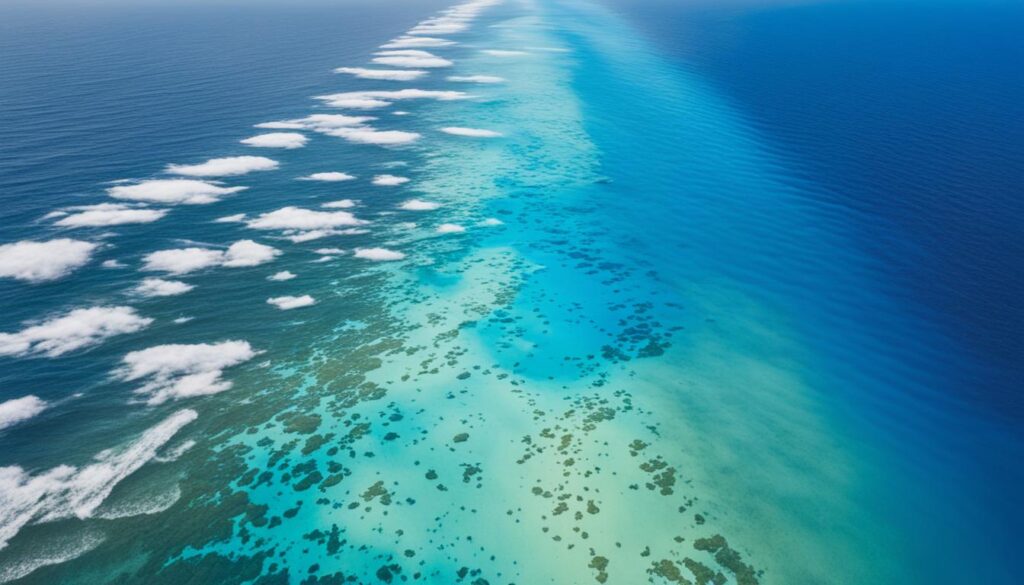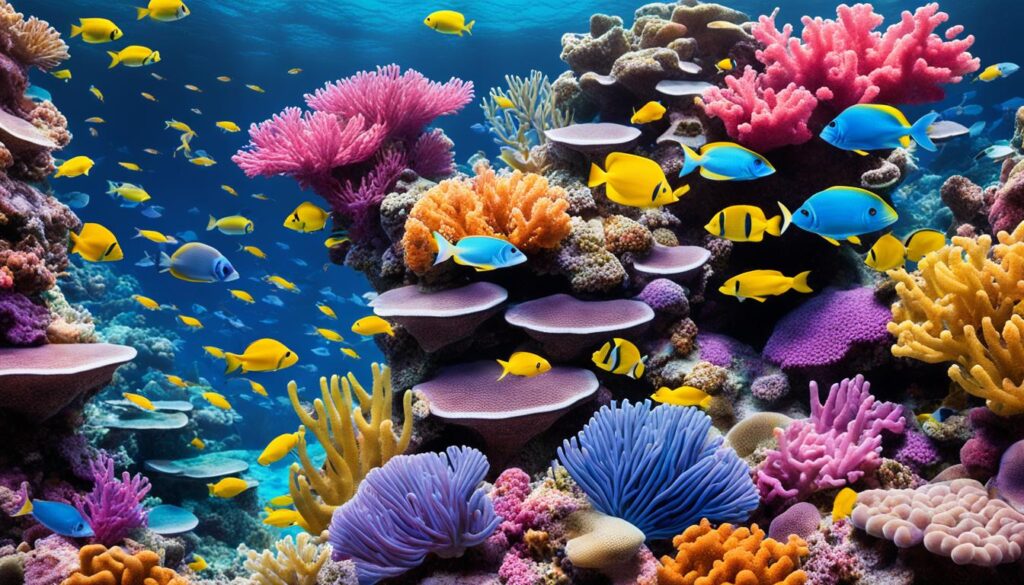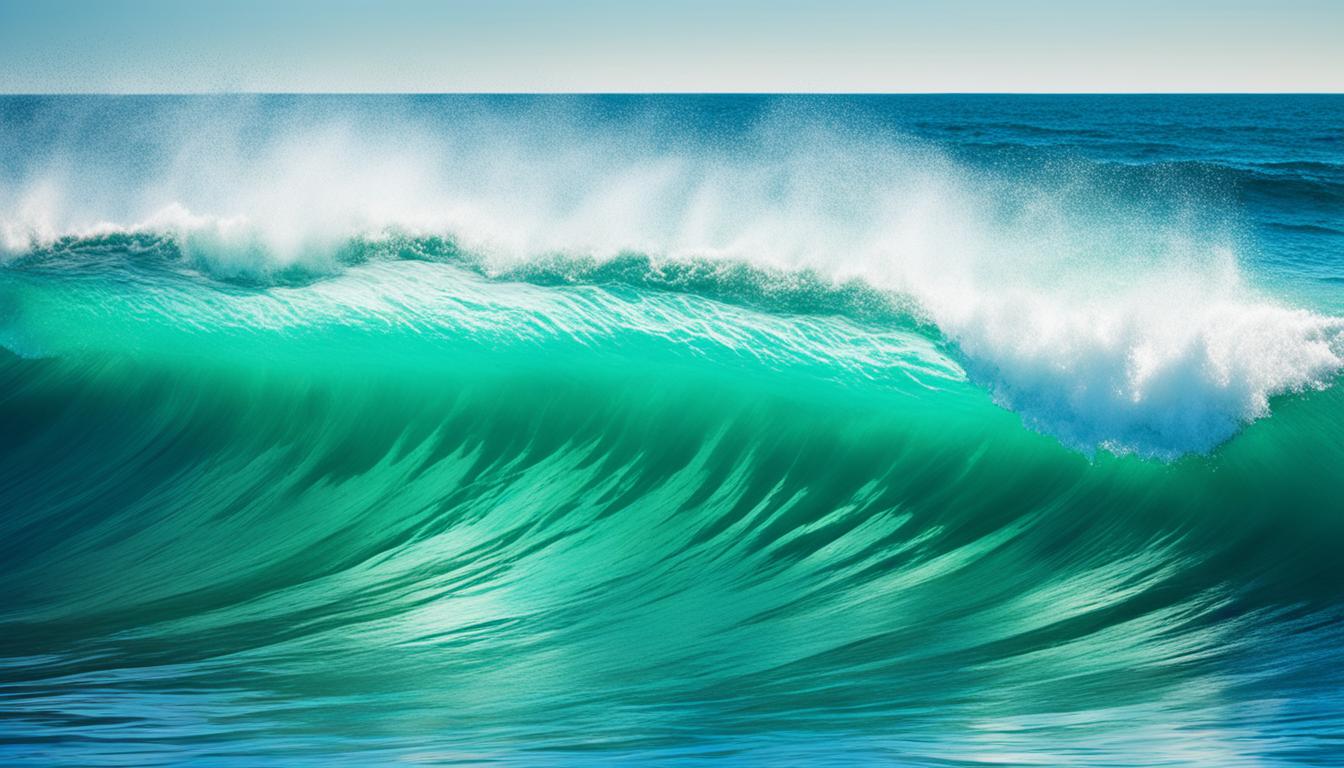The world’s oceans are changing fast, with over half of their surface showing new colors in the last 20 years123. This change is mainly due to climate change, showing how marine ecosystems are losing balance. The main reason for this color shift is the changing number of phytoplankton. These tiny plants are key to the ocean’s food chain and absorb carbon dioxide.
Satellites have helped track these important changes in ocean color123. By looking at how blue and green light reflects off the ocean, scientists see oceans turning greener, especially in warm areas12.
Key Takeaways
- More than 56% of the world’s oceans have changed color over the past two decades, shifting towards a greener hue.
- Satellite data has been crucial in detecting these subtle changes in ocean color, which go beyond natural year-to-year variations.
- The primary driver of this color change is the fluctuating populations of phytoplankton, which play a vital role in the marine food web and carbon dioxide absorption.
- Climate change, particularly rising global temperatures, is the leading cause of the changing ocean colors.
- The effects of climate change are already being felt in surface marine microbial ecosystems, as evidenced by the changes in ocean color.
The Role of Phytoplankton
Phytoplankton are tiny plants that live in the ocean and make their own food from sunlight. They are key to the ocean’s food chain, feeding everything from small fish to whales4. They also help the planet by taking carbon dioxide from the air and putting it into the ocean4.
Phytoplankton and Marine Food Web
Phytoplankton are the main food source for many ocean creatures, from tiny zooplankton to big whales4. This food chain depends on how many phytoplankton there are and where they live. If phytoplankton levels change, it can affect the whole ocean4.
Phytoplankton and Carbon Dioxide Absorption
Phytoplankton are also key in fighting climate change. They take carbon dioxide out of the air and store it in the ocean4. This helps keep the air clean and slows down global warming4. But, as the climate warms up, phytoplankton might not be able to do this job as well4.
| Key Facts about Phytoplankton |
|---|
| – Phytoplankton are microscopic, photosynthesizing organisms that contain chlorophyll4 |
| – They form the foundation of the marine food web, sustaining a wide range of marine life4 |
| – Phytoplankton play a significant role in the global carbon cycle by absorbing carbon dioxide from the atmosphere4 |
| – Changes in phytoplankton populations and distribution can have far-reaching impacts on marine ecosystems4 |
“Phytoplankton are the ocean’s powerhouses, driving the marine food web and playing a crucial role in regulating atmospheric carbon dioxide levels.”
Satellite Monitoring of Ocean Colors
Satellite technology has made it easier for scientists to watch the oceans’ colors change. The MODIS on NASA’s Aqua satellite has been key in this effort. It has given us data on ocean color changes for the last 20 years56.
MODIS looks at the ocean’s color in seven different colors. This gives us a clearer picture of the ocean’s color spectrum than before. Researchers use this info to make models and simulations. These help them figure out why ocean colors are changing5.
Studies show that over half (56%) of the oceans have changed color in the last 20 years. Climate change is the main reason for this57. The tropics and subtropics are seeing more green in the ocean. This is because warmer temperatures and changes in nutrients are helping phytoplankton grow7.
Phytoplankton are tiny plants that are key to the ocean’s food web. Climate change affects them a lot. Changes in ocean currents, nutrients, and acidity can change where and how many phytoplankton live. This affects the ocean’s color6.
“Even though the changes in ocean colors are not visually perceivable to the naked eye, they have the potential to impact ecosystems and human activities.”
As we deal with climate change, studying ocean colors from space is very important. It helps us understand how our oceans are doing and how they work. By watching these changes, scientists can learn more about how climate affects oceans and the important role of phytoplankton6.
Detecting Climate Change Signal Amid Natural Variations
Watching the oceans’ changing colors is a key way to see how climate change affects marine life. But, it was hard to spot long-term changes before because of the big year-to-year changes in chlorophyll levels8.
Monitoring the Entire Visible Spectrum
Now, scientists look at the full range of colors from the ocean’s surface. This helps them spot big trends in ocean color that match global warming’s effects8. This method makes it easier and quicker to see how climate change is changing marine life8.
Challenges in Tracking Chlorophyll Levels
Before, tracking phytoplankton meant watching chlorophyll levels. But, it took at least 30 years to see any climate change trend because of natural changes in chlorophyll9. Now, looking at the full spectrum of ocean colors lets scientists spot climate changes in just 20 years8.
The MODIS has been watching the Earth since 1999 in seven colors. This lets scientists study ocean color changes over time8. With this data, they’ve found clear trends in ocean color changes that show human-caused climate change’s big impact9.
The ocean’s color changes show shifts in plankton communities. These changes affect the food chain and how the ocean absorbs carbon9. By using satellite images, scientists learn about marine ecosystem health, the global carbon cycle, and climate change’s effects on oceans9.
“Monitoring just chlorophyll would require at least 30 years to see any effect from climate change; however, we could detect climate-related changes in ocean colors within 20 years due to smaller natural variations in other ocean colors.”
– Stephanie Henson, Co-author
Why the world’s oceans are changing colour
The oceans are changing in a big way, with many areas showing new colors over the last 20 years10. In fact, over 56% of the oceans have seen big color changes in the past two decades10. This change is most seen in warm and tropical areas, affecting 12% of the ocean where plants that make food for the ocean changed a lot10.
Climate change caused by humans is the main reason for these color changes in the oceans1011. A new way to study ocean colors found climate change effects in just 20 years, which old methods would take 30-40 years to spot10. This shows how fast climate change is affecting the oceans.
Changes in ocean color show how marine life is changing. These changes are because the ocean is getting layered due to warming, making it hard for nutrients to mix11. This affects the balance of life in the ocean10.
| Key Findings | Details |
|---|---|
| Over 56% of the world’s oceans have experienced significant color changes in the past 20 years | 10 |
| Changes are most pronounced in tropical and subtropical regions, covering 12% of the ocean’s surface | 10 |
| New analysis methods can detect climate change trends in 20 years, compared to 30-40 years with traditional methods | 10 |
| Over the past 20 years, researchers detected shifts in colors across more than half of the world’s oceans | 11 |
| The study looked at seven hues of ocean color monitored by the MODIS-Aqua satellite from 2002 to 2022 | 11 |
These findings show how big an impact climate change is having on the oceans. It’s vital to keep watching and studying to understand these changes and their effects on ocean life1011.

Climate Change as the Driving Force
Studies show that climate change is the main reason for the changes in ocean color worldwide12. Scientists used computer models to see how the oceans would change with and without greenhouse gases. They found that adding greenhouse gases would lead to big changes in ocean color in just 20 years, affecting half the oceans12. This matches what satellites have shown, proving that human actions are behind the ocean color changes, not nature.
Modeling Ocean Color Under Climate Change Scenarios
Computer simulations give us a peek into how climate change will change the oceans’ colors in the future13. By 2100, over half of the oceans could look different because of climate change13. Subtropical areas might turn bluer, and polar regions could get greener due to changes in tiny sea plants called phytoplankton13.
The models match real-world satellite data well13. This makes them trustworthy for predicting the oceans’ future under climate change13.
The ocean is key in the global carbon cycle, taking in about 25% of human-caused CO2 emissions14. But with CO2 levels over 410 parts per million in 202014, the ocean is struggling to handle the extra heat and carbon. This leads to ocean warming, acidification, and changes in marine life, showing up in the oceans’ changing colors.
Impact on Marine Ecosystems
The changes in ocean color show shifts in phytoplankton populations. These changes affect marine ecosystems15. In the last 20 years, 56% of the oceans turned from blue to green because of climate change15. NASA satellites show the ocean’s color change is huge, bigger than the whole planet15. This green color comes from phytoplankton, key organisms in the ocean15. They make food for many sea creatures and help make oxygen for us.
As the planet warms up, phytoplankton shifts will move towards the poles at about 35 km (21 miles) a decade1511. This will change where zooplankton and other sea life live. It could make some sea areas less rich in species and others more so11. This could greatly affect the marine food web and the ocean’s balance.
| Metric | Value |
|---|---|
| Ocean color changes detected | Over 50% of the world’s oceans in the past 20 years11 |
| Phytoplankton shift rate | 35 km (21 miles) per decade towards higher latitudes15 |
| Expected impact | Declines in species richness in the tropics, increases in temperate and subpolar regions11 |
11 NASA’s Pace mission in January 2024 will study the ocean to better understand these color changes.
“The changing ocean color has implications for surface marine microbial ecosystems, indicating effects of climate change.”

Potential Changes in Carbon Uptake
Changes in phytoplankton communities could change how the ocean absorbs and stores carbon dioxide16. Different plankton types absorb carbon dioxide at different rates. Shifts in their numbers could change the ocean’s ability to store carbon17. This is key because the ocean helps take carbon dioxide out of the air, which fights climate change.
Varying Abilities of Plankton Types
Phytoplankton, tiny marine plants, are vital to the ocean’s food web and carbon cycle16. Some phytoplankton species are better at taking in and storing carbon dioxide than others17. As climate change changes phytoplankton communities, it might affect how much carbon the ocean can absorb.
| Plankton Type | Carbon Uptake Efficiency |
|---|---|
| Diatoms | High |
| Dinoflagellates | Moderate |
| Cyanobacteria | Low |
As the climate changes, plankton types might change too, with some doing better and others worse17. This could impact how well the ocean can absorb and store carbon dioxide. This is important for fighting climate change.
“Understanding how changes in phytoplankton communities could affect the ocean’s carbon uptake is crucial for predicting the future impacts of climate change on the global carbon cycle.”
Scientists are watching how phytoplankton populations change and what it means for the ocean’s carbon storage1617. By learning about plankton types, scientists can guess how the ocean might change as a carbon sink with climate change.
Conclusion
This study shows that the oceans are changing color due to human-induced climate change18. These changes are linked to shifts in phytoplankton communities and marine ecosystems18. This could have big effects on the ocean and all life in it18.
We need to keep watching and studying these changes closely. They could greatly affect marine life and how the ocean helps with the carbon cycle1819. It’s crucial to fight the bad effects of human-induced climate change on marine ecosystems18.
Understanding and fighting climate change is key. The knowledge from this research on ocean color changes will help us protect our oceans1819.
FAQ
What is causing the changes in ocean color observed globally?
What is the role of phytoplankton in marine ecosystems?
How are researchers using satellite data to monitor changes in ocean color?
Why was it difficult to detect climate change signals in ocean color data in the past?
How have researchers been able to overcome this challenge?
What percentage of the world’s oceans have experienced significant changes in color over the past two decades?
What does the study’s computer modeling suggest about the link between climate change and the observed changes in ocean color?
How might the changes in phytoplankton communities impact marine ecosystems?
How can the changes in phytoplankton communities affect the ocean’s ability to absorb and store carbon dioxide?
Source Links
- Climate Change Is Changing the Color of the Ocean
- Study: The ocean’s color is changing as a consequence of climate change
- Oceans are changing color, likely due to climate change, researchers find
- Why the world’s oceans are changing colour
- Climate Change Is Shifting the Color of Earth’s Oceans
- Climate change is changing the ocean’s color — and fast, scientists say
- Climate change is making our oceans change color, new research finds | CNN
- Oceans turning greener due to global warming
- Ocean color has changed significantly over the past 20 years
- Climate Change Lends New Color to the Ocean
- Oceans are changing colour and climate change may be to blame
- Climate Change is Affecting the Color of the Ocean
- Climate change to trigger shift in color of world’s oceans by end of the century
- Effects of climate change on oceans
- How Does Climate Change Impact the Ocean Colour? | Earth.Org
- The ocean’s color is changing as a consequence of climate change, study finds
- Climate change is making our oceans change color, new research finds
- Ocean’s colour change: A consequence of climate change
- Climate change has shifted colour of over half of world’s oceans: Study

